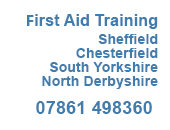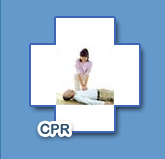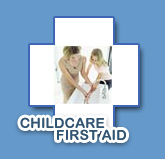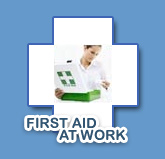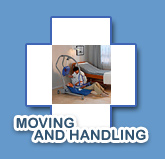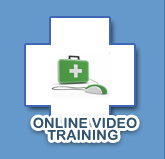Lockdown 2021 meant we all had more time to do "Remote training" and also " Online training." Many people are still using these methods. Look on our relevant pages for these courses but also get in touch directly with us for more information and help as sometimes we can put extra courses on at short notice , if the one you want isn't listed. We are here to help and there is no such thing as a daft question.
We are doing "Blended" training for all our Emergency First Aid at Work level 3 , First Aid at Work level 3 and First Aid at Work Requalifier level 3 courses. This will also include the Forestry courses as well. We are already doing the Paediatric First Aid level 3 "Blended"course. Blended courses are just an alternative method of delivering the courses , and means you spend less time with the instructor, because you do the theory online beforehand and in your own time and pace. The end qualification is exactly the same one you would get, as if you attended the old style instructor only courses. So now you have a choice of what fits in best with you.
HSE have insisted that all First Aid at Work type courses MUST have the practical elements in them, so cannot be done just online. OFSTED have also applied this to the Paediatric First Aid level 3 courses as well.
Basically, we have been doing "Blended" Paediatric First Aid since about 2012 , and it is the most popular way for us to deliver the course this way according to feedback.
By changing to a "Blended" format it reduces the face to face classroom time and also because of less time away from work it is popular with employers and the self employed as well.
The "blended" course consists of two parts :
Online part which is basically the theory element. This involves watching the course videos online and then a compulsory test at the end. This MUST be completed BEFORE attending the practical element. You do not have to watch the videos all in one go , and each time you log off then back on again, it will return you to the last video you watched. We will email you the link required for the online part when you book the "practical" element with us, or if you book on using the relevant orange widgets on the course dates page it will allow you to book the "part 1" online training by ticking the "part 1 training box" where you enter your details.
Practical element with the instructor , face to face, to go through the practical training.
The two parts together then become the level 3 qualification.So the end qualification is the same as before, it is just the delivery method is different.
During "lockdown" a lot of training has changed to "online", and we think this "blended" training is the way for training to be going in the future.
We invoice you for the practical element only and this is what you see on our course cost page. You pay yourself for the Online part when you log on for the first time , and we will email you a link to get to the online part. or you can do it yourself if you book using the orange widget. So please remember there are two separate parts , the online and the practical.
We will put more details on the relevant pages, but if you have any questions at all about any "blended" training, please get in contact as it will be new to lots of people, whereas we have actually been doing it for years with the paediatric courses so also have ironed out any problems.
Remote Access training
We have Remote training courses for the theory based type of courses so you can do some of the trainer led stuff online with us (via Zoom which we will organise everything for you) and you can interact with the instructor. This is all Virtual/Remote Access training is, so it is done online but with a live instructor so you can ask questions, get explanations etc. A bit like using Facetime or Skype to speak to someone. This is definitely how a lot of the training will be done in the future.
It also means you can do the training from your own home, or at work. In fact any location where you can get internet access and a quiet environment.
You will just need a phone, tablet or laptop with webcam and microphone and internet access. Your webcam and microphone MUST be working as you will use them during the remote training. If you do not have a webcam and microphone, or you switch them off during the training, you will not be able to successfully complete the course as these are required for assessment purposes as well as the interaction.
Training Quality Assurance
We are an "Approved Centre" for Protrainings.uk and many of our courses are run through them. As such we have to comply with all their centre requirements, policies , procedures and quality assurance. We are also internally and externally quality assessed.
Endorsements, Approvals and Recognitions achieved by ProTrainings :
ISO 9001
ISO 45001
ISO 27001
CPD Certification
CPD Provider of Training Excellence
TQUK Diamond Approved Centre
Skills for Care Centre of Excellence
Federation of First Aid Training Organisations Endorsement
Online training
You just need a phone, tablet or laptop and internet access for all of the online training.
Through ProTraining , we can offer over 220 Online courses that can be done anywhere, so long as you have internet access.
You can book on as an individual, or if a company booking is required , contact us and we can arrange that with you as well.
The Online courses can be done in your own time and at your own pace. Many of them are video based and you will get access to all resources you need to complete them.
Each time you log on, the online training should return you to the last part you looked at, and you can always go back or rewind any videos.
We have put widgets/links on right side of this home page and also on our Online Training page, for you to look at all of the Online courses available and book on.
Any questions at all, do please either email or phone so we can explain and put you at ease as this is fairly new to all of us .
Course queries:
Because of the number of face to face or remote courses we can offer, it is impossible to run all of them every month.
If you are interested in a particular course and it has no course date listed, then please just get in touch as we will usually be able to help.
info@coreteachingsolutions.co.uk
07861 498360
CPR update for Covid 19/Corona Virus
The following is direct from the UK Resus website for anyone who is performing CPR/defibrillation in an out-of-hospital setting. The link is www.resus.org.uk/media/statements/resuscitation-council-uk-statements-on-covid-19-coronavirus-cpr-and-resuscitation/covid-community
Whenever CPR is carried out, particularly on an unknown victim, there is some risk of cross-infection, associated particularly with giving rescue breaths. Normally, this risk is very small and is set against the inevitability that a person in cardiac arrest will die if no assistance is given. The first things to do are shout for help and dial 999.
Because of the heightened awareness of the possibility that the victim may have COVID-19, Resuscitation Council UK offers this advice:
-
Recognise cardiac arrest by looking for the absence of signs of life and the absence of normal breathing. Do not listen or feel for breathing by placing your ear and cheek close to the patient’s mouth. If you are in any doubt about confirming cardiac arrest, the default position is to start chest compressions until help arrives.
-
Make sure an ambulance is on its way. If COVID 19 is suspected, tell them when you call 999.
-
If there is a perceived risk of infection, rescuers should place a cloth/towel over the victims mouth and nose and attempt compression only CPR and early defibrillation until the ambulance (or advanced care team) arrives. Put hands together in the middle of the chest and push hard and fast.
-
Early use of a defibrillator significantly increases the person’s chances of survival and does not increase risk of infection.
-
If the rescuer has access to personal protective equipment (PPE) (e.g. FFP3 face mask, disposable gloves, eye protection), these should be worn.
-
After performing compression-only CPR, all rescuers should wash their hands thoroughly with soap and water; alcohol-based hand gel is a convenient alternative. They should also seek advice from the NHS 111 coronavirus advice service or medical adviser.
Paediatric advice
We are aware that paediatric cardiac arrest is unlikely to be caused by a cardiac problem and is more likely to be a respiratory one, making ventilations crucial to the child’s chances of survival. However, for those not trained in paediatric resuscitation, the most important thing is to act quickly to ensure the child gets the treatment they need in the critical situation.
For out-of-hospital cardiac arrest, the importance of calling an ambulance and taking immediate action cannot be stressed highly enough. If a child is not breathing normally and no actions are taken, their heart will stop and full cardiac arrest will occur. Therefore, if there is any doubt about what to do, this statement should be used.
It is likely that the child/infant having an out-of-hospital cardiac arrest will be known to you. We accept that doing rescue breaths will increase the risk of transmitting the COVID-19 virus, either to the rescuer or the child/infant. However, this risk is small compared to the risk of taking no action as this will result in certain cardiac arrest and the death of the child.
Mental Health
Lets get people talking about it, not being embarrassed and us listening which is sometimes all it takes. Understanding more about it, signs to look for and support to give someone
Mental Health in the whole community and at work is often overlooked, or not talked about, or sometimes "just get on with it."
We are now running Mental Health in the Workplace courses levels 1,2 & 3.
Although title is"workplace", it covers Mental Health of people, regardless of where they are .
Our Mental Health in the Workplace courses can be done remotely , as an online course or in the classroom. Please look at our page on this for more information and dates of courses.
The courses are to help us listen, how to start a conversation, look for signs, how we can help, what support maybe we can offer and organisations too. We are not diagnosing at all, that is for the professionals. What we are doing is understanding the persons situation and encouraging them.
We would love you to come onto our courses but genuinely, if you don't and go somewhere else, it is more important that you are doing something about it, because we feel Mental Health does need more understanding, help and support than it is getting at present. So please just do it.
We can book individuals or groups onto our training courses.
Our Training Methods
- Face to face
- Remote Access
- Online
- Group Discussion
- Personal experience
- Demonstration
- Hands on practice
- Observation
- Online E- learning
- Student Manuals
- Powerpoint
- Manikins
- Barriers
- Dressings
- Triangular Bandages
- Epipens
- Tourniquets
- Haemostatic Dressings
- AED
- Universal Sling
- Slide Sheets
- Transfer Boards
We provide Courses :
- Face to face
- Remote access
- Online
- Sheffield
- Chesterfield
- North Derbyshire
- South Yorkshire
- Onsite Nationwide
Online courses :
Over 220 coures that can be done Online, and especially now if we all have more time at the moment because of covid 19 virus lockdown. Even we are doing some Online courses ourselves, so no excuse.
Click on the links below to find out more details about the Online courses on offer.
